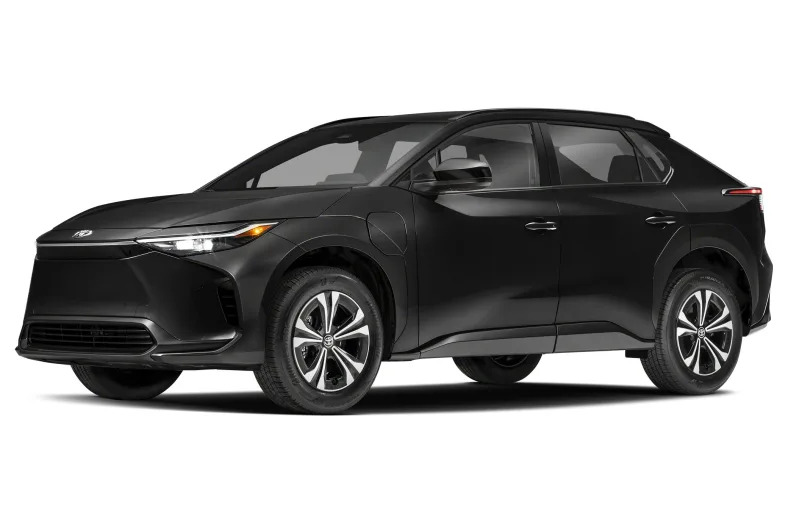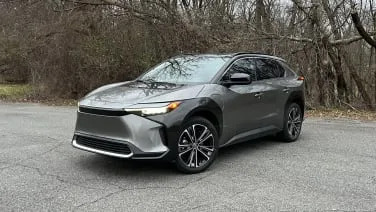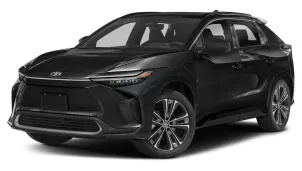2024 Toyota bZ4X
Industry
Pros: Good value with FWD; a relatively conventional small SUV; ample cargo space for the segment; high ground clearance for an EV Cons: Subpar range with AWD; slower to charge than some rivals; shine-in-your-eyes interior trim; hide-your-eyes styling The 2024 Toyota bZ4X represents the second year on the market for Toyota’s first mass-market electric vehicle, and there are very few changes. It still represents a very cautious dipping of the toe into the battery-electric market with a safely and conservatively styled competitor in the popular compact crossover segment. The bZ4X doesn’t really do anything to raise the bar in terms of design, technology or electric powertrain. It’s a safe bet for someone, likely a repeat Toyota buyer, who likes the looks and feel of their RAV4 but wants to go fully electric. If that sounds like you, just know there are better options out there. It's also important to know that it is a virtual twin of the Subaru Solterra. One key difference: the Toyota bZ4X is available with either front- or all-wheel drive, whereas the Solterra is predictably AWD only. Its standard front-drive layout also stands it apart from many other EVs whose two-wheels-driven (and cheapest) option is usually a rear-wheel-drive layout. That means that going the value route with the base XLE FWD trim means you’ll secure the most driving range — 258 miles — while sacrificing little in drivability in the Snowbelt. Moving to all-wheel-drive or to the higher Limited trim, though, you’ll end up with lackluster driving range while taking a bigger hit to your pocketbook. But that entry-level bZ4X does present a decent value with an appropriate level of equipment, interior quality and range. But someone asking more of their EV, and of the money they put down for it, will probably be better off with a Hyundai Ioniq 5, Kia EV6 or Volkswagen ID.4 rather than opt for a more expensive Toyota. Interior & Technology | Passenger & Cargo Space | Performance & Fuel Economy What it's like to drive | Pricing & Trim Levels | Crash Ratings & Safety Features What's new for 2024? The 2024 bZ4X carries over with a few minor changes to standard equipment. All versions now come with a dual-level (Level 1 and Level 2) mobile charging cord. The Advanced Park hands-free parking assist is standard on the Limited trim. The XLE trim gets a standard power liftgate and eight-way power driver’s seat. There’s updated charging information for range and charging time estimates in the infotainment system. Toyota also offers a year of free public charging at EVGo stations. Also, you’ll see a small increase in pricing across the board. What are the bZ4X interior and in-car technology like? The bZ4X strikes a nice balance between functionality and achieving the more futuristic aesthetic typically demanded of an EV. Basically, it’s not too weird. There are physical toggles for temperature settings and the accompanying touch-sensitive climate buttons are illuminated and responsive enough (that said, we’d prefer a volume knob). The shifter …
Full Review
Pros: Good value with FWD; a relatively conventional small SUV; ample cargo space for the segment; high ground clearance for an EV Cons: Subpar range with AWD; slower to charge than some rivals; shine-in-your-eyes interior trim; hide-your-eyes styling The 2024 Toyota bZ4X represents the second year on the market for Toyota’s first mass-market electric vehicle, and there are very few changes. It still represents a very cautious dipping of the toe into the battery-electric market with a safely and conservatively styled competitor in the popular compact crossover segment. The bZ4X doesn’t really do anything to raise the bar in terms of design, technology or electric powertrain. It’s a safe bet for someone, likely a repeat Toyota buyer, who likes the looks and feel of their RAV4 but wants to go fully electric. If that sounds like you, just know there are better options out there. It's also important to know that it is a virtual twin of the Subaru Solterra. One key difference: the Toyota bZ4X is available with either front- or all-wheel drive, whereas the Solterra is predictably AWD only. Its standard front-drive layout also stands it apart from many other EVs whose two-wheels-driven (and cheapest) option is usually a rear-wheel-drive layout. That means that going the value route with the base XLE FWD trim means you’ll secure the most driving range — 258 miles — while sacrificing little in drivability in the Snowbelt. Moving to all-wheel-drive or to the higher Limited trim, though, you’ll end up with lackluster driving range while taking a bigger hit to your pocketbook. But that entry-level bZ4X does present a decent value with an appropriate level of equipment, interior quality and range. But someone asking more of their EV, and of the money they put down for it, will probably be better off with a Hyundai Ioniq 5, Kia EV6 or Volkswagen ID.4 rather than opt for a more expensive Toyota. Interior & Technology | Passenger & Cargo Space | Performance & Fuel Economy What it's like to drive | Pricing & Trim Levels | Crash Ratings & Safety Features What's new for 2024? The 2024 bZ4X carries over with a few minor changes to standard equipment. All versions now come with a dual-level (Level 1 and Level 2) mobile charging cord. The Advanced Park hands-free parking assist is standard on the Limited trim. The XLE trim gets a standard power liftgate and eight-way power driver’s seat. There’s updated charging information for range and charging time estimates in the infotainment system. Toyota also offers a year of free public charging at EVGo stations. Also, you’ll see a small increase in pricing across the board. What are the bZ4X interior and in-car technology like? The bZ4X strikes a nice balance between functionality and achieving the more futuristic aesthetic typically demanded of an EV. Basically, it’s not too weird. There are physical toggles for temperature settings and the accompanying touch-sensitive climate buttons are illuminated and responsive enough (that said, we’d prefer a volume knob). The shifter …
Hide Full Review
Hide Full Review
Retail Price
$43,070 - $49,260
MSRP / Window Sticker Price
| Engine | |
| MPG | Up to 131 city / 107 highway |
| Seating | 5 Passengers |
| Transmission | 1-spd auto |
| Power | 201 - 214 hp |
| Drivetrain | all wheel, front-wheel |
| Curb Weight | 4,266 - 4,464 lbs |
Smart Buy Program is powered by 





